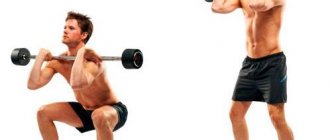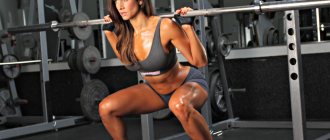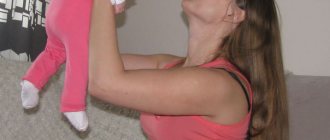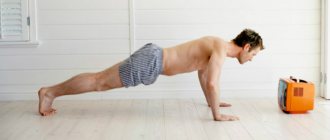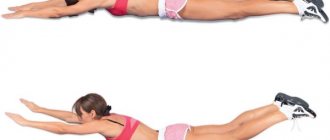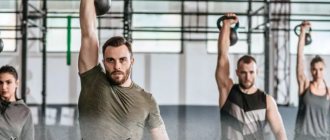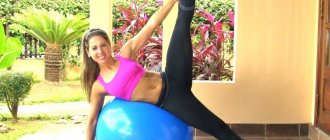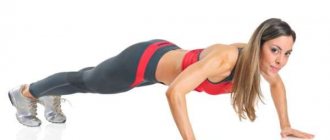Every girl dreams of rounded buttocks and slender legs. Unfortunately, not everyone has been endowed by nature with such beauty, so many have to make a lot of effort to achieve their desired dream. Squats are considered the best assistant in the pursuit of ideality. In the article you can learn how to squat correctly in order to get a positive result; how to create a training schedule.
- Squats for girls Why they are useful
- Contraindications and harm
Squats for girls
Girls can pump up their buttock muscles both at home and in the gym. The location of training does not affect the effectiveness of training, nor does it affect the benefits and possible harm.
Read more about the benefits of squats for men and women.
Why are they useful?
So, what are squats for?
- make a large group of muscles work (not only the legs, but also the body);
- improved blood circulation, which makes it possible to improve metabolism (and this, in turn, affects the condition of the skin);
- posture correction (it is impossible to perform a squat correctly without a straight back and a toned stomach);
- improving general condition (regular exercise is very useful for increasing endurance);
- intense calorie loss, which is what most girls dream of achieving.
Contraindications and harm
On the path to perfection, obstacles may arise in the form of health problems. Squats are contraindicated if you have certain diseases.
Important! Some diseases of the cardiovascular system and musculoskeletal system (hypertension, scoliosis, osteochondrosis) can be eliminated or alleviated with the help of squats.
But for this you need to consult a doctor, since only he can assess the severity of the disease and decide whether squats will be beneficial or aggravate the condition. These include:
- injuries and problems with joints and leg bones;
- hypertension;
- varicose veins;
- cardiovascular diseases;
- scoliosis;
- hernia;
- excessively overweight.
Squats can be harmful only in a few cases:
- some experts believe that this exercise can harm joints and tendons if they are stretched and therefore weakened;
- joints and tendons can be injured when squatting with too much weight;
- Doing the exercise incorrectly can result in serious injury.
Familiarize yourself with the techniques and rules of squats.
What muscles are in action?
The gluteus maximus muscle is responsible for the shape of the buttocks, and the gluteus maximus muscle is responsible for their roundness - the middle and small muscles, which lift the gluteus maximus muscle. These muscles are loaded more than others when squats.
In addition to them, the following are also used:
- quadriceps;
- calf;
- popliteal;
- hamstring biceps;
- muscles of the lower back;
- press.
Squat Rules
It is very important to perform the correct squat, since it determines how effectively the muscles will work and how quickly positive changes can be expected.
So, here are some rules and recommendations for performing the exercise:
- In order for the squat to be correct, you cannot lower your pelvis below knee level.
- Breathe evenly and naturally. Tighten your muscles as you inhale and relax as you exhale.
- Lower and rise without jerking.
- The main thing is not the number of times, but their quality.
- When moving down, the hip joint should bend first, and then the knee.
- Keep your back straight and your shoulders back and down. There should be a slight deflection in the lumbar area.
- Do not bring your knees beyond your feet. Keep them level.
- Concentrate your body weight on your heel, but do not lift your foot off the floor.
- Always warm up, especially if you are going to squat with a load.
- Start practicing the technique of performing the exercise without weight. When you understand all the subtleties, you can use weights.
- Take your time during squats. It is important to feel the work of each muscle.
- Break the required number of squats into at least 4 sets. Between them, pause for 5-10 minutes.
Video: how to squat correctly
How to execute the program correctly
Many people can be intimidated by the number of squats they need to do in a day.
But this is not difficult, since they are not done at once. The exercise is performed in four sets with a break of 1 minute. Therefore, the largest number of squats at a time is performed on the last day of the month - 75 times.
But by the 30th day of classes it will be easy. Of course, in the first days, muscle pain may appear due to lack of habit, but gradually it will become easier to exercise. And to relieve pain, you can take a hot bath.
But not everyone can withstand such a heavy load. If even on the first day you cannot squat the required number of times, don’t worry, you can slightly adjust the program. The first time it can be performed with fewer squats.
The number of repetitions in this case will not exceed 170 times. But in order to be able to build up muscles with such a program, there are only three days off per month. Rest is provided by alternating days with more and less workload.
After this, you can begin performing the classic squat program. It is this that will help pump up the muscles of the buttocks and thighs more effectively.
To maintain the effect, you can continue to squat after finishing the program.
It is recommended to do no more than 50 squats in one approach. If you really liked the program, after a short break you can repeat it, making the exercise a little more complicated, for example, squatting with weights. This will help you achieve an ideal figure and always be in excellent physical shape.
This squat program in just a month will help improve the shape of your hips and buttocks, strengthen your muscles and reduce body fat. And if you combine exercises with proper nutrition, its effectiveness will greatly increase.
Before performing the complex, be sure to warm up: it will help make the muscles more flexible and the workout more effective. Plus it will reduce the likelihood of joint damage.
To better work the gluteal muscles, squats should be performed as deeply as possible. To avoid damaging your knee joints, do not make sudden movements.
Types of squats at home
The most common type of squats is classic. Stand straight, feet shoulder-width apart, arms extended forward. The back and neck are straight. As you inhale, slowly lower yourself down. At the bottom point, fixate for a second and, exhaling, return to the starting point.
Learn how to properly squat with a barbell on your shoulders, as well as how to properly do front squats with a barbell and Bulgarian squats.
Others are based on this type of exercise:
- Deep. Its technique is similar to the type described above, only the pelvis needs to be lowered slightly below the knee line. In this case, his muscles will stretch and tense more.
- On one leg. Stand up straight. Raise one of your lower limbs up in front of you without bending the knee. Stretch your upper limbs forward. Squat down slowly without lowering or bending your raised leg. At the bottom point, the raised leg and the thigh of the working leg should form a single straight line.
Important! If it is difficult to maintain your balance, you can hold on to a support at first.Rise also slowly, while lowering your arms.
- With weights. You can use a barbell as a load. Stand up straight and place the apparatus on your shoulders. Spread your feet 50-60 cm from one another. Slowly lower yourself down, trying to squat as deeply as possible. The back should remain straight. Also slowly return to the starting point.
- Plie (sumo, squat) with wide legs. Spread your feet as wide as possible. Turn your socks in different directions. Back straight, look ahead. Slowly lower yourself down until your thighs form a right angle with your shins. Fix for a second or two at this point and smoothly return to the starting point. To complicate the exercise, you can squat with a weight (dumbbell), but only after the technique has been worked out.
- With narrow leg position. It is difficult to perform this exercise without special preparation, as it requires good muscle stretching and ligament flexibility. Place your feet narrower than shoulder width.
Important! There is a variant of this type of squat when the feet are together. But in this case it is much more difficult to maintain balance, but the effectiveness is the same.The following steps are similar to classic squats.
- Curtsy. It is a combination of lunges and squats. Stand straight, feet shoulder-width apart or slightly narrower (as you prefer). Step one leg back so that your feet are on the same diagonal. Keep your body weight on your working leg, the second one stands on the “pad”. Start squatting until the thigh of your supporting leg forms an angle with your shin. The knee of the second leg is a short distance from the floor. Straighten up and put your foot down. Then you can change it, performing the exercise in turn for each limb (or perform it first for one and then for the other).
Squats for a perfect butt without leaving home
Many women dream of having ideal shapes, but cannot bring themselves to go to the gym.
Squats are an effective and simple exercise that helps you achieve a slim and beautiful figure without leaving home. This is a great way to build muscles in the buttocks area.
Subscribe to our INSTAGRAM account!
Squats also improve blood circulation, help get rid of cellulite, increase the body's internal reserves, and make your muscles strong and elastic.
In the process of squats, fat is effectively burned, coordination of movements is improved, and metabolism is accelerated. At the same time, you do not need special equipment and a lot of space for training.
The proposed 30-day marathon of squats is recommended specifically for those who dream of rounded and elastic buttocks. These exercises for the figure, if performed correctly and regularly, will give impressive results in just a month.
Classes begin with performing a small number of squats and gradually increase them. Take short breaks from training to allow your muscles to rest and recover from exercise.
Squat complex for 30 days
In order for the classes to be as effective as possible, it is advisable to draw up a squat plan for the month. First, it is recommended to perform regular (classic) squats, and after your body gets used to the load a little, you can diversify with other types.
If you are in good physical shape, then you can immediately start with combinations of several types, and also add weight.
We advise you to read about how to properly squat with a barbell for a girl.
This is what a sample table of exercises for a month looks like:
| Day | First approach | Second approach | Third approach | Fourth approach | Total |
| 1 | 15 | 15 | 10 | 10 | 50 |
| 2 | 16 | 15 | 13 | 11 | 55 |
| 3 | 17 | 15 | 15 | 13 | 60 |
| 4 | DAY OFF | ||||
| 5 | 20 | 20 | 15 | 15 | 70 |
| 6 | 21 | 20 | 18 | 16 | 75 |
| 7 | 22 | 20 | 20 | 18 | 80 |
| 8 | DAY OFF | ||||
| 9 | 25 | 25 | 25 | 25 | 100 |
| 10 | 28 | 26 | 26 | 25 | 105 |
| 11 | 30 | 28 | 27 | 25 | 110 |
| 12 | DAY OFF | ||||
| 13 | 35 | 33 | 32 | 30 | 130 |
| 14 | 37 | 35 | 33 | 30 | 135 |
| 15 | 40 | 35 | 35 | 30 | 140 |
| 16 | DAY OFF | ||||
| 17 | 43 | 37 | 37 | 33 | 150 |
| 18 | 45 | 38 | 38 | 34 | 155 |
| 19 | 46 | 40 | 38 | 36 | 160 |
| 20 | DAY OFF | ||||
| 21 | 50 | 45 | 44 | 41 | 180 |
| 22 | 52 | 47 | 44 | 42 | 185 |
| 23 | 55 | 48 | 45 | 42 | 190 |
| 24 | DAY OFF | ||||
| 25 | 65 | 55 | 52 | 48 | 220 |
| 26 | 65 | 57 | 53 | 45 | 225 |
| 27 | 65 | 60 | 54 | 46 | 230 |
| 28 | DAY OFF | ||||
| 29 | 70 | 62 | 55 | 48 | 240 |
| 30 | 75 | 70 | 55 | 50 | 250 |
If this training schedule seems difficult to you, you can choose a more gentle option:
| Day | Total number of squats |
| 1 | 30 |
| 2 | 45 |
| 3 | 55 |
| 4 | REST |
| 5 | 75 |
| 6 | 90 |
| 7 | 120 |
| 8 | 120 |
| 9 | 90 |
| 10 | 110 |
| 11 | 150 |
| 12 | 95 |
| 13 | 100 |
| 14 | REST |
| 15 | 150 |
| 16 | 125 |
| 17 | 150 |
| 18 | 100 |
| 19 | 115 |
| 20 | 125 |
| 21 | 100 |
| 22 | 70 |
| 23 | 140 |
| 24 | 170 |
| 25 | 95 |
| 26 | REST |
| 27 | 140 |
| 28 | 100 |
| 29 | 160 |
| 30 | 145 |
Did you know? The record for squats with a barbell of 100 kg was set by Sergei Rachinsky, performing squats 212 times in 25 minutes.
This version of the training regimen, although it provides for fewer days with rest, but the number of squats per day is slightly less. The total number of times must be divided by the optimal number of approaches (preferably 4). Always rest at least 60 seconds between sets.
Squat Chart
| Day/Approaches | 1 approach | 2nd approach | 3 approach | 4 approach | Total |
| 1) Monday | 15 | 15 | 10 | 10 | 50 |
| 2) Tuesday | 16 | 15 | 13 | 11 | 55 |
| 3) Wednesday | 17 | 15 | 15 | 13 | 60 |
| 4) Thursday (Closed) | — | — | — | — | — |
| 5) Friday | 20 | 20 | 15 | 15 | 70 |
| 6) Saturday | 21 | 20 | 18 | 16 | 75 |
| 7) Sunday | 22 | 20 | 20 | 18 | 80 |
 Monday (Closed) Monday (Closed) | — | — | — | — | — |
| 9) Tuesday | 25 | 25 | 25 | 25 | 100 |
| 10) Wednesday | 28 | 26 | 26 | 25 | 105 |
| 11) Thursday | 30 | 28 | 27 | 25 | 110 |
| 12) Friday (Closed) | — | — | — | — | — |
| 13) Saturday | 35 | 33 | 32 | 30 | 130 |
| 14) Sunday | 37 | 35 | 33 | 30 | 135 |
| 15) Monday | 40 | 35 | 35 | 30 | 140 |
| 16) Tuesday (Closed) | — | — | — | — | — |
| 17) Wednesday | 43 | 37 | 37 | 33 | 150 |
| 18) Thursday | 45 | 38 | 38 | 34 | 155 |
| 19) Friday | 46 | 40 | 38 | 36 | 160 |
| 20) Saturday (Closed) | — | — | — | — | — |
| 21) Sunday | 50 | 45 | 44 | 41 | 180 |
| 22) Monday | 52 | 47 | 44 | 42 | 185 |
| 23) Tuesday | 55 | 48 | 45 | 42 | 190 |
| 24) Wednesday (Closed) | — | — | — | — | — |
| 25) Thursday | 65 | 55 | 52 | 48 | 220 |
| 26) Friday | 65 | 57 | 53 | 45 | 225 |
| 27) Saturday | 65 | 60 | 54 | 46 | 230 |
| 28) Sunday (Closed) | — | — | — | — | — |
| 29) Monday (Final) | 70 | 62 | 55 | 48 | 240 |


